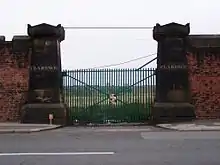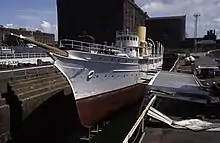Clarence Dock (Liverpool)
Clarence Dock was a dock on the River Mersey, England, and part of the Port of Liverpool. Situated in the northern dock system in Vauxhall, it was connected to Trafalgar Dock.
| Clarence Dock | |
|---|---|
 Clarence Dock entrance | |
| Location | |
| Location | Vauxhall, Liverpool, United Kingdom |
| Coordinates | 53.4191°N 3.0019°W |
| OS grid | SJ334918 |
| Details | |
| Opened | 16 September 1830 |
| Closed | 1928[1] |
| Type | Wet dock |
| Area | 6 acres (2.4 ha), 273 sq yd (228 m2)[2] |
| Width at entrance | 47 ft (14 m)[3] |
| Quay length | 914 yd (836 m)[3] |
History
Designed by Jesse Hartley, the dock opened on 16 September 1830.[4] Clarence Dock was named after William, Duke of Clarence, who became William IV.[5]
It was built as a self-contained steamship dock facility.[1] This was to avoid the risk of fire to wooden-hulled sailing vessels then using the other docks.[5][6]
The dock was the berth for the Irish ferry ships. During the Irish famine in the 1840s over 1.3 million Irish people travelled through the dock. After many weeks or months, many took a ship to America from Waterloo Dock, there being no direct sailings to America from Ireland. However many thousands made their home in Liverpool. Others moved to London and other British towns and cities.[5]
The dock closed in 1928,[1] and in 1929 was filled in when the site was redeveloped as power station.[7]
Clarence Dock power station
Clarence Dock power station was constructed for Liverpool Corporation in 1931 to be an integral part of the local electricity grid system supplying electricity throughout Liverpool.[8] The station plant comprised a low pressure station (No. 1) and a later high pressure station (No. 2) both based on coal-fired, water tube boilers and steam turbine driven alternators.
The plant in the low pressure station (installed 1931–32) comprised:[9]
Boilers (all coal-fired)
- 4 × 160,000 pounds per hour (20.16 kg/s) of steam at 450 psi and 775°F (31.0 bar and 413°C)
- 4 × 200,000 lb/hr (25.20 kg/s) of steam at 450 psi and 775°F (31.0 bar and 413°C)
Turbo-alternators
- 2 × 51.25 MW twin cylinder Metropolitan Vickers, 1,500 rpm, 7,250 kV, 3-phase, 50 Hz.
The plant in the high pressure station (installed 1937–53) comprised:[9]
Boilers (all initially coal-fired, converted to oil-firing in the 1960s)
- 6 × 200,000 lb/hr (25.25 kg/s) of steam at 630 psi and 825°F (43.45 bar and 441°C)
- 1 × 250,000 lb/hr (31.5 kg/s) of steam at above conditions
- 5 × 350,000 lb/hr (44.1 kg/s) of steam at above conditions
Turbo-alternators
- 5 × 53.5 MW Metropolitan Vickers, 1,500 rpm, 33 kV, 3-phase, 50 Hz.
The generating capacity, electricity output and thermal efficiency of the stations were as shown in the tables.[9][10][11][12]
| Year | Net capability, MW | Electricity supplied, GWh | Thermal efficiency, % |
|---|---|---|---|
| 1954 | 97 | 332.131 | 20.39 |
| 1955 | 97 | 233.040 | 19.94 |
| 1956 | 97 | 193.322 | 19.46 |
| 1957 | 97 | 231.844 | 19.32 |
| 1958 | 97 | 185.421 | 19.03 |
| Year | Net capability, MW | Electricity supplied, GWh | Thermal efficiency, % |
|---|---|---|---|
| 1954 | 245 | 1203.070 | 24.25 |
| 1955 | 245 | 1317.984 | 24.93 |
| 1956 | 245 | 1361.523 | 24.68 |
| 1957 | 245 | 1257.017 | 23.90 |
| 1958 | 245 | 1130.607 | 23.05 |
| 1972 | 267.5 | 1101.661 | 23.60 |
| 1979 | 154 | 3.982 | –– |
| Year | Net capability, MW | Electricity supplied, GWh | Thermal efficiency, % |
|---|---|---|---|
| 1946 | 1225.699 | 23.03 | |
| 1961 | 370 | 843.204 | 22.12 |
| 1962 | 370 | 783.635 | 22.02 |
| 1963 | 370 | 952.591 | 22.09 |
| 1967 | 354 | 1052.1 | 23.42 |
By 1972 the No. 1 station had been decommissioned and the No. 2 station converted to oil firing. The No. 2 station was decommissioned in the early 1980s.
The three large chimneys of the Clarence Dock Power Station were a familiar local landmark, known as the Three Sisters,[13] until the power station was demolished in 1994.[1]
Present

The two Clarence Graving Docks are still extant and accessible via what remains of Trafalgar Dock. On 17 July 2006, Irish vocal pop band Westlife held a concert for their Face to Face Tour supporting their album Face to Face.
As part of the Liverpool Waters development, Clarence Dock will become one of the clusters of tall buildings. It was one of the two clusters of tall high-rise buildings which have been agreed between Peel Holdings and English Heritage.
In 2004 it was proposed that a 60,000 seater stadium for Everton FC be built at Kings Dock by the Mersey Docks & Harbour Company and the NWDA.[14][15] This would have included a rapid rail service to be financed by the NWDA.[16] Nothing became of this. However in 2016 Northern docks emerged as one of two possible new locations for a new ground for Everton.[17]
References
- Pollard & Pevsner 2006, p. 277
- Baines 1859, Part II, p. 91
- Baines 1859, Part II, p. 116
- "The Clarence Dock". Old Liverpool / Picture of Liverpool: Strangers Guide. 1834. Archived from the original on 13 May 2008. Retrieved 10 April 2008.
- "Clarence Dock Famine Memorial". irishseashipping.co.uk. Archived from the original on 31 May 2011. Retrieved 10 April 2008.
- "Trading Places: A History of Liverpool Docks (Clarence Dock)". Liverpool Museums. Archived from the original on 28 October 2008. Retrieved 10 April 2008.
- "Clarence Dock". Liverpool History Online. Archived from the original on 16 January 2009.
- Hannah, Leslie (1979). Electricity before Nationalisation. London: Macmillan. p. 132. ISBN 0333220862.
- Garrett, Frederick C. (ed) (1959). Garcke's Manual of Electricity Supply vol. 56. London: Electrical Press. pp. A-45, A-117-118.CS1 maint: extra text: authors list (link)
- CEGB (1972). CEGB Statistical Yearbook 1972. London: CEGB. p. 17.
- CEGB (1979). CEGB Statistical Yearbook 1978-79. London: CEGB. p. 8. ISBN 0902543598.
- Electricity Commission, Generation of Electricity in Great Britain year ended 31st December 1946. London: HMSO, 1947.
- "Tagged: Overhead Railway". Streets of Liverpool. Retrieved 30 August 2016.
- Gleeson, Bill (12 June 2004). "New pressure for clubs to agree ground sharing; £10m at risk with deadline a month away". Liverpool Daily Post. Retrieved 30 August 2016.
- http://www.nsno.co.uk/e107_images/newspost_images/plan1.jpg. Missing or empty
|title=(help) - http://www.nsno.co.uk/e107_images/newspost_images/plan2.jpg. Missing or empty
|title=(help) - Murphy, Liam (18 May 2016). "Images show vast scale of potential new Everton stadium site in Liverpool's docklands". Liverpool Echo. Retrieved 30 August 2016.
Further reading
External links
| Wikimedia Commons has media related to Clarence Dock. |
- "Liverpool North Docks diagram". Archived from the original on 8 January 2009.
- Site of Clarence Dock aerial photo
- Clarence Dock Power Station photo